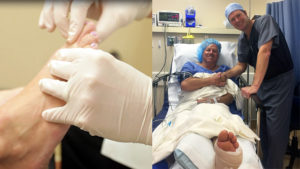Biomechanical conditions, improper footwear or lifestyle factors contribute to the common problem of foot and ankle pain. Sometimes, the pain subsides on its own and sometimes medical intervention becomes necessary. Over the counter painkillers are helpful in attaining temporary relief, however, the strategy is not a feasible option in the long term.
Foot pain can affect the quality of life in unimaginable ways. It might disturb the sleep cycle, affect an individual’s ability to function and lack of concentration may lead to severe challenges. In most cases, the symptoms of foot pain subside after a couple of days, however not every foot condition can be treated with at-home remedies. In some cases, surgeries become necessary. Today’s post is focused on a discussion of those foot conditions that are best treated with foot and ankle surgery. Delaying the treatment can make the condition worse, therefore, it is important to understand which foot conditions are best treated with surgical intervention.

- Bunions: Bunions are bony growth that develops at the base of the big toe. Bunions can be severely painful and if left untreated can affect an individual’s mobility. Although orthotic treatments are suggested for bunions, however, there is no assured solution to shrink bunions. Surgical treatment is the only feasible method to realign the toe. A podiatrist can remove the bony growth with surgical procedures to help the patients regain mobility.
- Hammertoes: Wearing shoes can become difficult with hammertoes. The condition is described when toes bend from the middle joint and cause pain. Wearing comfortable shoes and using shoe inserts can offer temporary relief however surgery is required to get rid of the pain. Hammertoes do not go away on their own therefore surgical interventions become necessary. In addition to this, surgery might also help in preventing the recurrence of hammertoes.
- Plantar fasciitis: The majority of adults seek heel pain treatment because of the common condition called plantar fasciitis. The condition results in inflamed plantar fascia, a tissue that connects the heel bone to the toe. In most cases, surgery is not needed. Stretching and physical therapy are considered the first options to relieve the tension. However, the approach of alternative medicine can take months and or years to heal the inflamed plantar fascia. On the other hand, the surgical approach is faster and more effective. Patients can function more efficiently after surgical detaching of fascia from the heel bone.
- Arthritis:It is a common foot condition that leads to stiff and painful joints. Surgery is not recommended when a person is diagnosed with arthritis. However, taking anti-inflammatory drugs is harmful for a longer duration. Therefore, in severe cases of arthritis surgery becomes essential. Surgeons remove the arthritic surface to reduce the likelihood of worsening the symptoms of arthritis.
- Sports injury: Foot and ankle fractures are most common in sports injuries. Not every injury is severe enough to be treated with a surgical method. In addition to this, a longer recovery period might also make surgery the least favorite option of athletes. However, an appointment with foot and ankle surgeons becomes essential when mobility is tragically impaired. The majority of sports injuries are treated by stabilizing the foot with casts, however severe fractures are only treated by surgeries in which the ankle and feet are stabilized with surgical screws and pins.
- Morton’s Neuroma:In this condition, nerves in the foot become inflamed and lead to pain and numbness. The symptoms can be managed with correction of foot posture, however, the condition does not disappear on its own and surgery becomes necessary. For chronic conditions, podiatrists recommend surgical removal of the affected nerve.
- Biomechanical conditions:In many cases, foot conditions are a result of biomechanical deformities. For instance, flat feet or high arches often result in painful conditions. The discomfort can be relieved with shoe inserts or orthotics, however, permanent relief can be attained with surgical reconstruction of the arch. For severely painful conditions, doctors recommend surgery as the best treatment option.
When is foot surgery necessary?
Severe sports injuries or abnormal growth required immediate surgical intervention. For other foot conditions, foot doctors often consider surgery as the last resort. It is recommended to consult a podiatrist for a thorough assessment of foot conditions. Depending on the results of the biomechanical assessment, doctors may determine the severity of the foot condition and suggest whether an alternative approach can be used for treatment or if surgery is required.
Conclusion
Surgery is not always the first-line treatment for the foot conditions which are listed above. An experienced podiatrist often recommends non-surgical interventions like physical therapy or orthotics. If foot conditions persist despite getting non-invasive treatment from a healthcare provider it is best to opt for surgical intervention. Contact the specialists at Orange County Foot and Ankle Group to determine the best course of treatment. The experts are highly recognized for best sports injuries treatment and best bunion surgery in Orange County.





Comments